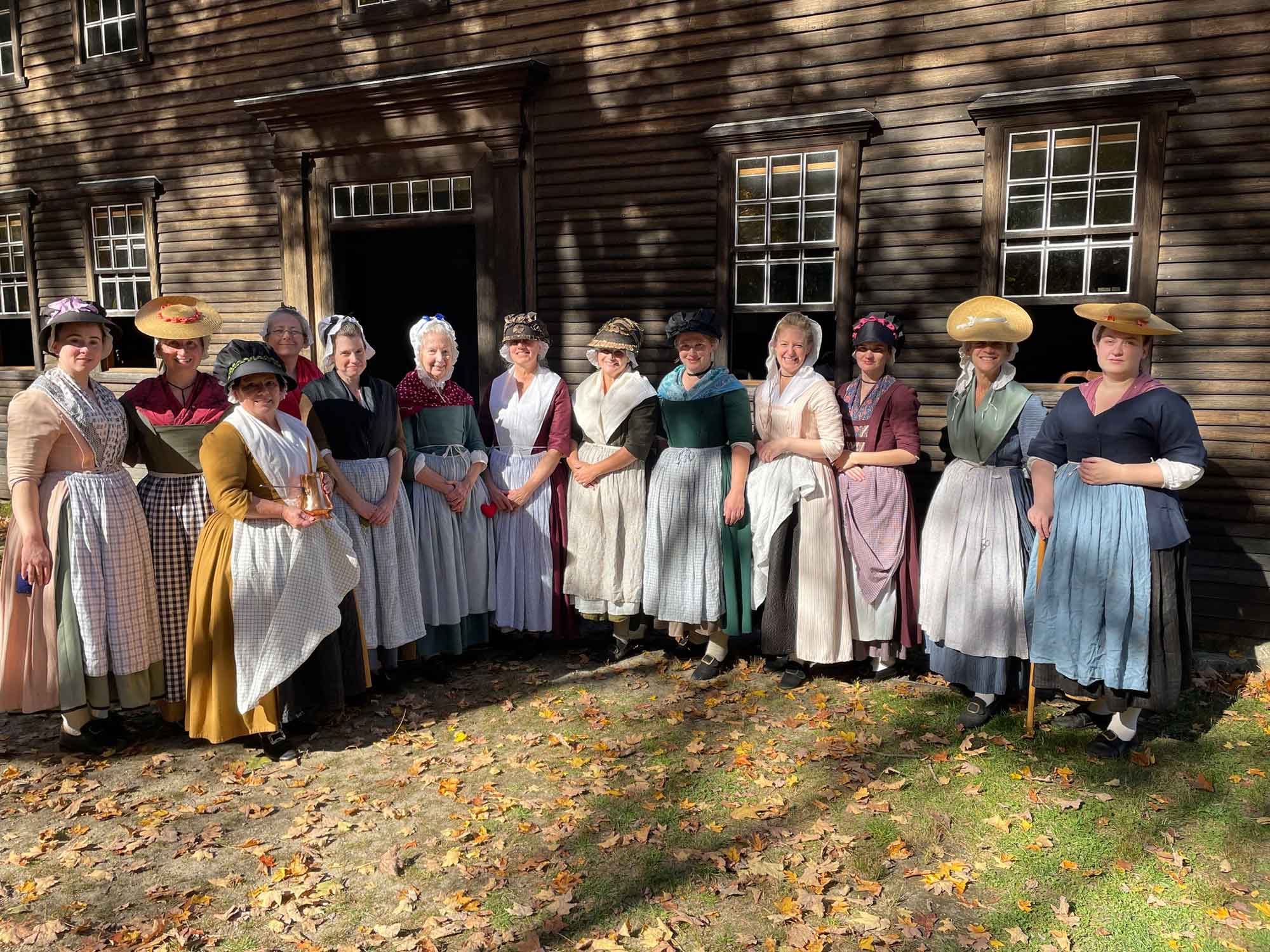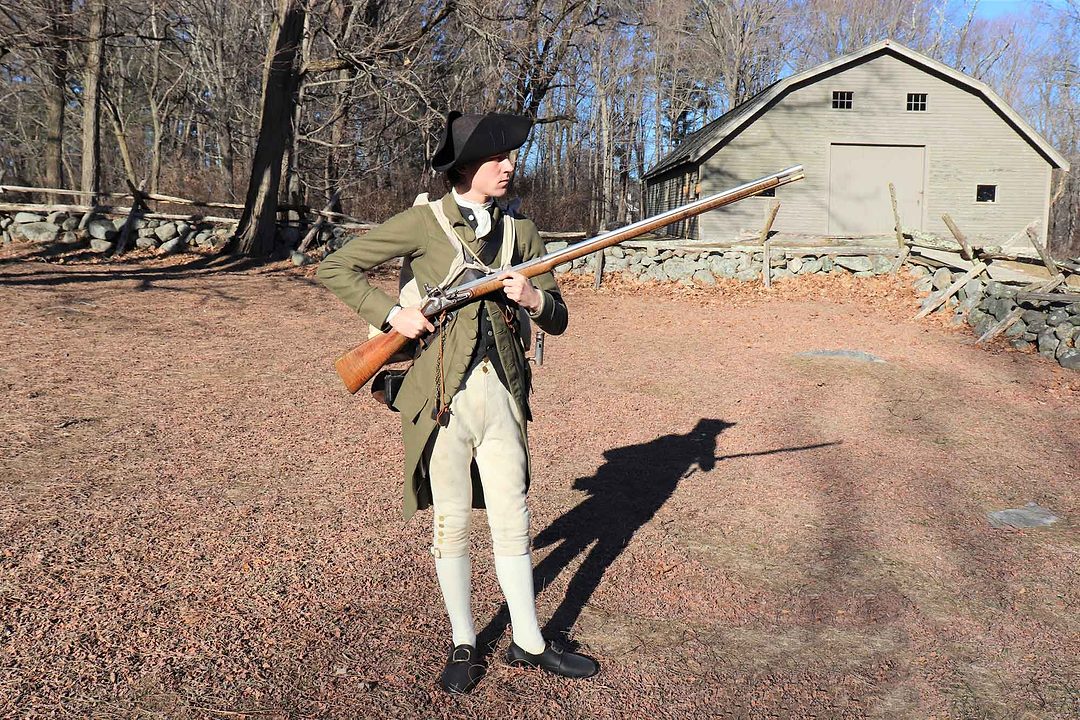 Spring is a time of rebirth, and with the melting of snow we begin to think about the blooming of flowers and the budding of trees as nature reawakens after her winter slumber. But in Concord, the arrival of spring brings to mind more warlike notions, and the sights and sounds of marching redcoats and militiamen fill the town as Concord commemorates the April 19, 1775, Battles of Lexington and Concord.
Spring is a time of rebirth, and with the melting of snow we begin to think about the blooming of flowers and the budding of trees as nature reawakens after her winter slumber. But in Concord, the arrival of spring brings to mind more warlike notions, and the sights and sounds of marching redcoats and militiamen fill the town as Concord commemorates the April 19, 1775, Battles of Lexington and Concord.
Tourists are enthralled with these figures from the past, and even lifelong Concordians enjoy seeing these breeches-clad, musket-toting visitors.
But who are these time travelers? Why do they insist on bringing the stories of our founding fathers and mothers to life? I recently had the chance to sit down and chat with two colonial living historians to find out how they came to be involved with Patriots’ Day.
For Larissa Sasgen, living history has been a part of her life since she was a child. Originally from Illinois, she was born into a reenacting family, and wore colonial clothing from an early age. She received her degree in music performance from Northern Illinois University and, in 2007, made the move to Massachusetts after getting a spot as a fifer with the Middlesex County Volunteers, one of the premier fife and drum units in the country. She moved to the area one week before Patriots’ Day and was immediately enthralled with being so close to Concord.
“Concord was always such a mythical place to me,” she said. And here she was, about to take part in the Patriots’ Day parade with the Middlesex County Volunteers! It wasn’t long before she got involved with Revolutionary War reenactment groups, and she was soon volunteering at Minute Man National Historical Park. It’s safe to say that Patriots’ Day has become one of her favorite days; she still marches in the parade with the Middlesex County Volunteers and takes part in living history programs with Minute Man National Historical Park.
Like Larissa, Jarrad Fuoss began his love of history at an early age. Growing up in central Pennsylvania, his parents took him to Gettysburg when he was about eight years old. Already into history, he was “absolutely hooked” on that trip, and seeing a Civil War reenactment at Gettysburg “sealed the deal” for him; he knew that American history would be his lifelong passion. That passion led to Jarrad getting his dream job with the National Park Service in 2014 as a park ranger at Gettysburg, where he got involved in Civil War living history. He visited Concord in 2018 and saw that Minute Man National Historical Park (MMNHP) was hiring, and by the following year he was a park ranger at MMNHP, talking about the shot heard ‘round the world at the North Bridge.
Jarrad was well aware of Concord’s importance in American history, and he was also aware of the significance of MMNHP’s role in telling the stories of the Battles of Lexington and Concord. One of the reasons Jarrad wanted to be in Concord was because of the Park’s reputation for historic interpretation and that it was “the place to be” for living history programs. Indeed, the living history programs at the Park are second to none in their authenticity.
And then COVID hit. There was no Patriots’ Day celebration in 2020 and in 2021 the events were all virtual. Jarrad spent those two years reading everything he could about the Battle of Concord, April 19, and eighteenth-century weapons and clothing. His first “real” Patriots’ Day was in 2022. So how was it? “It was AWESOME,’’ he told me, with a big smile.
Larissa agrees that Patriots’ Day in Concord is indeed awesome, and she describes it as the “historian’s Super Bowl.” Both she and Jarrad mentioned that they have gotten chills on Patriots’ Day; being in Concord on April 19, wearing eighteenth-century clothing, and walking on the same ground where the battles were fought is an emotional experience they get to relive every year.

Larissa in the Smith House at MMNHP
| ©Jim HollisterSo why do it? Why wear several layers of wool and linen and run around pretending you’re somebody else? It’s Jarrad’s job and is Larissa’s hobby, but to both of them it’s also a way of life. “I don’t know what normal people do for a hobby.” Larissa said. But the main reason they do it is to educate the public – and themselves – about eighteenth-century life.
The sheer amount of information available about a single day in 1775 that they use for research is mind-numbing. All good living history interpreters will spend hours and hours combing through period accounts describing the first day of the American Revolution; research is key if you want to accurately and realistically portray a person that lived 248 years ago. It’s not enough to just wear the right clothing. They need to learn how and why they’re wearing the clothes they have on and how to use the tools and weapons they are working with. Every stitch, every button, every musket is a gateway into the eighteenth-century and the people who lived back then. There’s no detail too small that won’t be used to tell the stories of 1775.

The women of the Ladies Association of Revolutionary America
| ©Ruth HodgesIt wasn’t just soldiers who experienced April 19, 1775. Civilians were affected too. A few years ago, Larissa became involved with the Ladies Association of Revolutionary America (LARA), a living history group started by Ruth Hodges to research and portray the women who lived through the first day of the American Revolution. The group is an added dimension to the story of Patriots’ Day, giving a complete picture of the events surrounding April 19. Patriots’ Day activities now include a portrayal of the women and children who lived along Lexington Road in 1775 and how they bundled up belongings and valuables and evacuated Concord as the British regulars approached the town. The research of primary documents, such as letters and diaries from those who lived through it, help the women of LARA give voice to those evacuees uprooted by the conflict.
Although Patriots’ Day comes only once a year, for Jarrad and the staff at Minute Man National Historical Park it’s a year-long event. When I asked him when preparations begin for the big day, Jarrad replied, “It never really stops!” Taking their cue from the park’s Living History and Historic Weapons Program Coordinator, Jim Hollister, the NPS rangers, staff, and volunteers are often planning the next Patriots’ Day events soon after they wrap up the one they just participated in.
The time and money that Jarrad, Larissa, and hundreds of others put into their accurate portrayal of eighteenth-century people is well worth the effort. These time travelers who recreate militiamen, redcoats, farmers, housewives, children, and even ministers, bring the eighteenth-century back to life on Patriots’ Day. They do all that reading, research, sewing, and military training so that we can experience with them what it was like to be in Concord on April 19, 1775. The pageantry, the bravery, the worry, the fear, the sadness: it all comes back to us through the hard work and dedication of these living history interpreters. They make history real for us. And Patriots’ Day just wouldn’t be the same without them.


